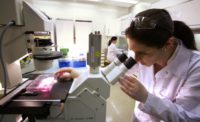It’s an unfortunate fact that food recalls still occur too often. And with the FDA’s focus on ready-to-eat (RTE) foods, the dairy industry is no exception. For example, there have been more than 20 recalls of various types of cheeses due to Listeria monocytogenes concerns thus far in 2017.
The pathogen of most interest to the dairy industry from an environmental viewpoint is Listeria monocytogenes, due to the selective nature of the cold wet environments associated with the industry. However, if the conditions of the environment are warmer or even drier (think spray-dried dairy products), Salmonella must also be considered.
A robust, holistic and comprehensive environmental monitoring program (EMP) is the best ammunition for fighting against potential recalls and to protect your company against an FDA swabathon. Performing a risk and hazard assessment of your processing and surrounding environments is not only prudent, but also necessary to determine what pathogen you will be targeting and where in the environment to look.
Take a seek-and-destroy approach
These risk assessments should be conducted as a multi-disciplinary team and with outside subject matter experts to properly consider all potential sites for the EMP. When a properly designed EMP is executed, it takes into consideration not only transient pathogens, but also “house pets” — persistent pathogen strains that have free room and board in harborage areas in and around equipment. The purpose of a well-designed and implemented EMP is a seek-and-destroy approach to identify the transients, as well as to evict the house pets that have become unwanted in the environment.
When deciding on sample sites for your EMP, it is always good to see what areas will provide you with the most information in just a few swabs. An example would be to collect the condensate coming off several cooling units. This is a composite that will monitor the condition of these units and verify that cleaning and sanitation practices are sufficient to prevent a growth niche for Listeria from developing.
Monitor, inspect control panels, drains
Some other areas that often go unmonitored and inspected are control panels, electrical conduits and electrical race tracks. Control panels are notorious for providing growth formation opportunities for Listeria. A good practice is to number all control panels and put them on an inspection schedule, as well as on your EMP. Keep in mind that any inspection of these areas absolutely requires an electrician to be present and a lock-out tag out to be exercised.
The same approach should be applied to drains. A schematic of the drains should be in all EMP risk assessments. First, directional flow must be considered. Drains sometimes flow from the raw side of the food production facility to the RTE side before finally exiting the facility. These drains are underground subway systems for pathogens. Knowing when production schedules, as well as sanitation schedules, occur will greatly help to ensure raw cleaning schedules do not result in aerosols rising in the RTE areas, cross-contaminating the finished product.
A drain system review should also look for dead ends in the drain system that were, at one point, functional drains. These present great opportunities for pathogens to get established and may be a large reason why some drains are always problematic with positive swab results.
No one-size-fits-all plan
The number of swabs that should be taken overall varies from facility to facility. It highly depends on the environmental risk assessment. During this assessment, many criteria need to be evaluated.
First, the plant must consider the type of process and how much exposure the RTE product will have to the environment prior to packaging. Second, it must consider the type of operations, type of product and associated risks to determine how many lines will be monitored, the number of shifts and the frequency. However, 10 or fewer swabs per month in any RTE area within a production facility would probably be inadequate.
Last, all EMPs should have an “unusual event” section. Simply stated, increased swabbing should occur when construction is underway, equipment is being moved or purchased from outside the RTE area, processing changes are being made or anything else outside the ordinary is taking place.


